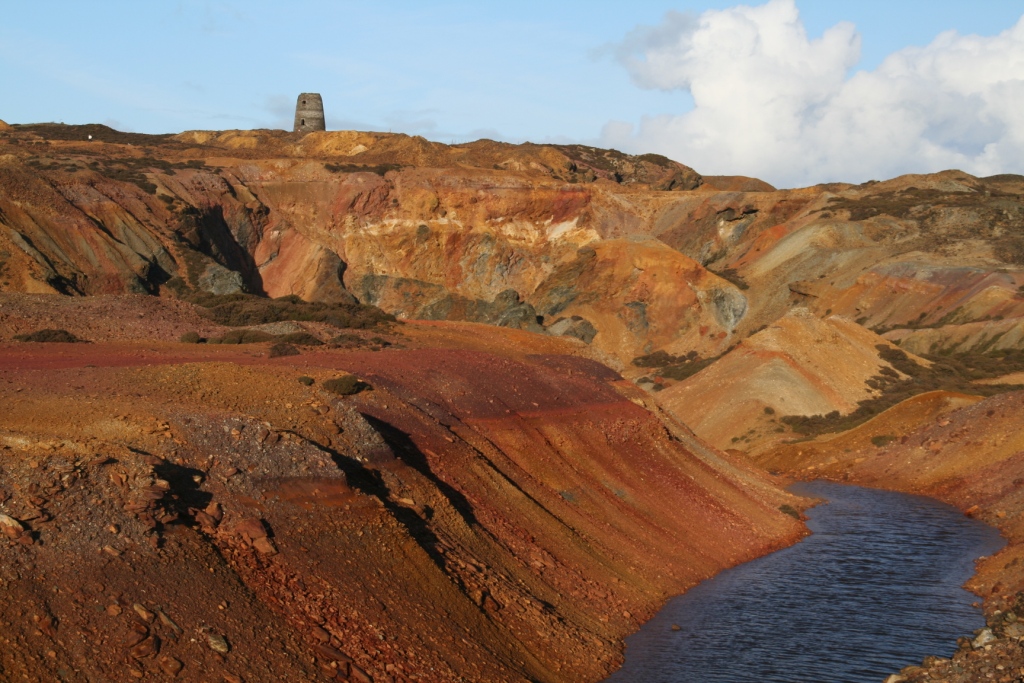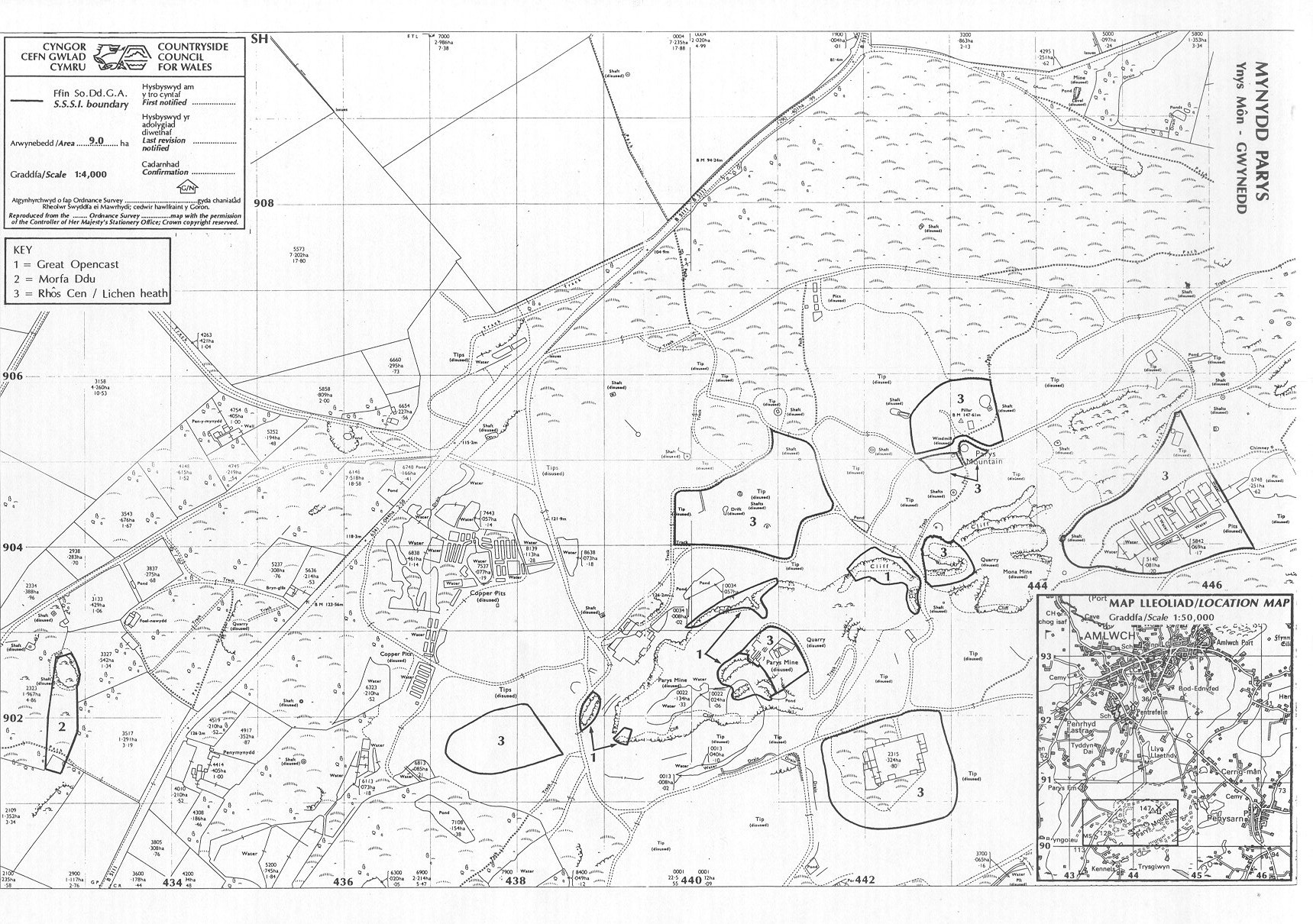MYNYDD PARYS (PARYS
MOUNTAIN) SSSI
A dramatic landscape of
orange and
purple rocks, much-loved by science-fiction film-makers. The mountain
has been mined for copper and other minerals since Roman times. Some
consider it derelict land, others a giant earth sculpture! Public
footpaths cross the site and there is on-site
interpretation/information by the Amlwch Industrial Heritage Trust. The
sulphides in the rocks produce very acid conditions (and very acid
waters in the Afon Goch "red river" - actually two rivers which flow
north to Amlwch and south to Traeth Dulas) and this and the highly
toxic metals still present in the ground result in a very sparse and
specialised flora able to tolerate these demanding conditions. Rinsing
equipment and footwear in freshwater afterwards is recommended!

The
fantastically colourful landscape of
Mynydd Parys, Anglesey,
bears witness to a
time when the area was globally important for mining. At the end of the
18th
century, Mynydd Parys was the largest producer of copper in the world,
producing more than 3,300 tons of ore every year. It has been estimated
that
over 130,000 tons of copper were extracted from the ore mined at Mynydd
Parys.
Mining
began here in the Bronze Age and copper
ingots have been found that bear Roman inscriptions. Large-scale
extraction
began in the 1760s following the discovery of a major ore-body known as
the
Great Lode. The North Discovery, Golden Venture, Carreg-y-doll,
Charlotte’s and
Morfa-du lodes were subsequent discoveries. Initially, the ore was
worked at
the surface and then in opencast pits, before deeper deposits were
exploited by
means of shafts and adits. As is the case with the remains of other
Welsh
mines, the Great Opencast bears witness to the human endeavour that was
expended in extracting the copper in this area, under conditions that
are
hardly imaginable today.
It
was difficult and dangerous work, and
contemporary visitors referred in awe to the steepness of the shafts
and the
agility of the miners. Those who kept their footing were in danger from
falling
rocks and the gunpowder used to blast the ore. Women and children did
not work
down the mines, but above ground; ‘copper ladies’
used hammers and knock stones
to separate the valuable copper from the waste rock - not a pleasant
job but
probably better than the conditions underground, despite the noxious
fumes from
the kilns used to smelt the copper. Famous visitors included Michael
Faraday,
whose 1819 diaries refer to the ‘noble roar’ of the
gunpowder blasting.
The
acidic waters of Mynydd Parys are
rich in metals and it was discovered that purer metal (although in
small
amounts) could be obtained efficiently from drainage water using direct
precipitation of copper onto scrap iron placed in purpose-built ponds.
The
mineral-rich water was also much in demand by local farmers to treat
foot rot
in sheep.
The
mining industry was so important that
the area even had its own coinage to pay the workers; the ‘Parys
Mountain
penny’, struck in the mine’s own copper, was first
minted locally in 1787.
These tokens, which were made in various forms until 1817 (and even
generated
forgeries), are now highly collectible. Halfpennies were also made and
it is
estimated that over 10 million coins were issued.
Other
industries linked to the copper
mining on Anglesey
included sulphur and
sulphuric acid manufacture, fertiliser and ochre and paint pigments.
Mynydd
Parys had been largely worked out by the 1890s and production ceased in
1911.
The
copper, lead and zinc mineralization
at Mynydd Parys occurs in zones found in volcanic rocks and deep-water
mudstones of Ordovician and Silurian age, rather than in veins, as is
often
seen in other mineral deposits. Although its origins remain the subject
of much
debate, the deposit is believed to have formed as a result of
exhalation
(outpourings) of metalliferous brines on the Ordovician sea floor
during
volcanic activity some 450 million years ago.
The
primary minerals found at Mynydd Parys are
pyrite, galena, sphalerite and chalcopyrite. The site includes a wealth
of
secondary minerals that have developed through the weathering and decay
of the
primary minerals. Many of the secondary minerals are very rare,
including
anglesite which was named after the island of Anglesey
and first
described from Mynydd Parys. Mineral exploration continues today at
Mynydd
Parys, and resources are estimated at 6.5 million tonnes. These are
chiefly
copper and zinc ores, but also significant quantities of lead, silver
and gold.
Parts
of Mynydd Parys are designated as a Site
of Special Scientific Interest. This recognises not only the geological
significance of Parys Mountain,
but also its
unusual botany; rare lichens and other specially adapted species have
developed
on the harsh substrate.
Anglesey
map
SSSI Citation
Site Management Statement
Potentially Damaging Operations
list
Verical aerial photograph
Anglesey Minining plc website

Map
reproduced by permission of
Ordnance Survey ® on behalf of the Controller of Her Majesty's
Stationery Office. © Crown copyright. All rights reserved.
License
number 100044910.


